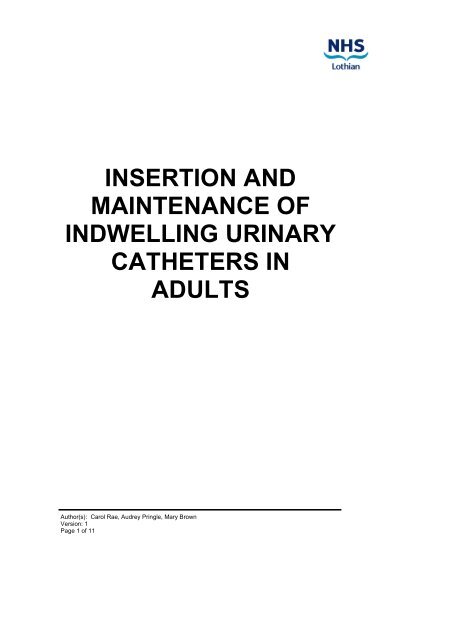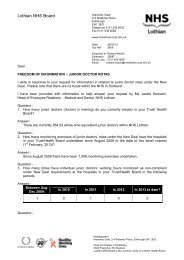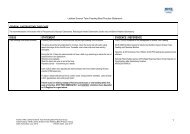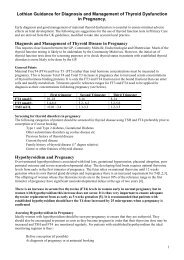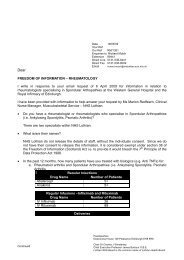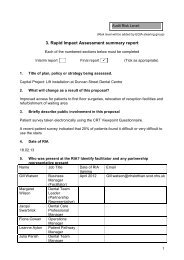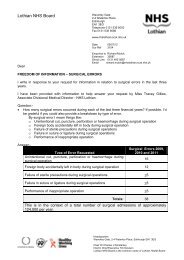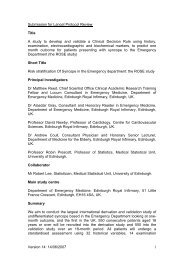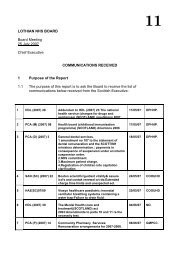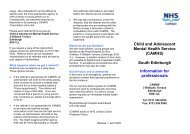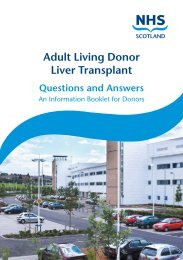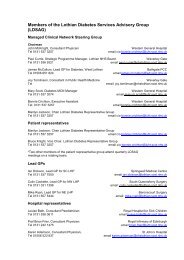Infection control manual - NHS Lothian
Infection control manual - NHS Lothian
Infection control manual - NHS Lothian
Create successful ePaper yourself
Turn your PDF publications into a flip-book with our unique Google optimized e-Paper software.
INSERTION AND<br />
MAINTENANCE OF<br />
INDWELLING URINARY<br />
CATHETERS IN<br />
ADULTS<br />
Author(s): Carol Rae, Audrey Pringle, Mary Brown<br />
Version: 1<br />
Page 1 of 11
Insertion and Maintenance of Indwelling Urinary Catheters in<br />
Adults<br />
Author(s): Carol Rae, Audrey Pringle, Mary Brown<br />
Version: 1<br />
Page 2 of 11<br />
Summary of Recommendations<br />
Date of Issue: March 2009 Date of Review: March 2012<br />
1. Aim<br />
Insertion and Maintenance of Indwelling Urinary Catheters in Adults<br />
2. Statement<br />
Catheter Associated Urinary Tract <strong>Infection</strong> (CAUTI) is the most common<br />
nosocomial infection. Catheterisation places patients in significant danger of<br />
acquiring a urinary tract infection (EPIC 2 2007). Urinary catheters are the<br />
second leading cause of blood stream infections (Health Protection Scotland<br />
2008).<br />
3.Requirements<br />
• A Health Care Professional who has been given formal training and is<br />
competent in the procedure<br />
• Where possible, informed patient consent should be obtained and<br />
documented<br />
• Prepare catheterisation equipment as per policy and ensure that<br />
materials used are not contraindicated for each individual patient use.<br />
• Consider containment options e.g. appropriate catheter bags for clinical<br />
situations<br />
4. Location<br />
This procedure can be undertaken in a hospital, care home or domiciliary<br />
setting.<br />
5.Timing<br />
When clinically indicated.<br />
6.Procedure<br />
1. Undertake procedure ensuring patient dignity and comfort is<br />
maintained<br />
2. Use of <strong>NHS</strong> <strong>Lothian</strong> Hand Hygiene Policy (2008) for<br />
catheterisation Procedure<br />
3. Thorough cleansing of glans penis/perineum to minimise risk of<br />
urinary track infection<br />
4. Procedure must be undertaken using <strong>NHS</strong> <strong>Lothian</strong> Insertion and<br />
Maintenance of Indwelling Urinary Catheters<br />
5. Maintain asepsis during procedure
6. Correct disposal of all equipment post procedure<br />
7. After Care<br />
• Regular review of necessity for indwelling urinary catheterisation using<br />
urinary Catheter Maintenance Bundle (Health Protection Scotland<br />
2008)<br />
• Use of closed link system between catheter and urine bag to minimise<br />
risk of Urinary Tract <strong>Infection</strong> (UTI). Only change urine bag weekly.<br />
• Risk assessment is required to determine appropriate level of Personal<br />
Protective Equipment (PPE)<br />
• Hand Hygiene in accordance with <strong>NHS</strong> <strong>Lothian</strong> Hand Hygiene Policy<br />
• Daily personal hygiene to minimise risk of urinary tract infection<br />
• Any abnormalities/problems related to catheterisation or after care<br />
must be clearly documented and shared with all staff providing the<br />
patient care<br />
• Symptomatic UTI’s should be treated as per <strong>NHS</strong> <strong>Lothian</strong><br />
“Management of Symptomatic Urinary Tract <strong>Infection</strong> in Catheterised<br />
Patients”<br />
• Patient leaflets are available on different aspects of catheterisation<br />
• Further information can be obtained from the Continence Specialist<br />
Nurses on 0131 537 4576 (Monday to Friday, 12.00-16.00) or the<br />
<strong>Infection</strong> Control Nurses (via the hospital switchboard Monday to<br />
Friday 8.00-16.00) or Microbiologist on call via hospital switchboard.<br />
Within secondary care advice is available by telephoning Nurse<br />
Urology, WGH 0131 537 1906/1874, Monday-Friday 8.00-17.30. For<br />
advice out with normal working hours please contact <strong>NHS</strong> 24.<br />
8.Obtaining a Urine Specimen – See page 10.<br />
9.Patient Education – See page 10.<br />
10.Further Help – See page 10.<br />
References – See page 10.<br />
Bibliography – See page 10.<br />
Author(s): Carol Rae, Audrey Pringle, Mary Brown<br />
Version: 1<br />
Page 3 of 11
Author(s): Carol Rae, Audrey Pringle, Mary Brown<br />
Version: 1<br />
Page 4 of 11<br />
<strong>NHS</strong> LOTHIAN<br />
INFECTION CONTROL MANUAL<br />
Insertion and Maintenance of Indwelling Urinary Catheters In Adults<br />
1. Aim To minimise the risk of urinary tract infection as a result of urinary<br />
catheterisation.<br />
2. Statement Catheter Associated Urinary Tract <strong>Infection</strong> (CAUTI) is the most<br />
common nosocomial infection. Catheterisation places patients in<br />
significant danger of acquiring a urinary tract infection (EPIC 2 2007).<br />
Urinary catheters are the second leading cause of blood stream<br />
infections (Health Protection Scotland 2008).<br />
Only use an indwelling urinary catheter after considering alternative<br />
options.<br />
Document the need for catheter insertion in the patient‘s notes.<br />
Follow Urinary Catheter Insertion bundle developed by Health<br />
Protection Scotland.<br />
Follow the Urinary Catheter Maintenance Bundle developed by Health<br />
Protection Scotland.<br />
Regularly review the patient’s clinical need for continuing urinary<br />
catheterisation and remove the catheter as soon as possible.
3.<br />
Requirements<br />
Healthcare Professional (HCP) who have been given formal training<br />
and are competent in the procedure.<br />
Author(s): Carol Rae, Audrey Pringle, Mary Brown<br />
Version: 1<br />
Page 5 of 11<br />
Sterile Dressing or Catheterisation pack.<br />
A non-sterile procedure pad to protect bedding<br />
Appropriately sized sterile catheter to facilitate urine drainage. Type<br />
of catheter will depend on anticipated duration of catheterisation,<br />
existing latex allergy, length required (standard or female) and patient<br />
choice. Please note that a standard length catheter must always be<br />
used to catheterize a male patient per urethra.<br />
Catheter balloon size should not exceed 10ml. Urological patients<br />
may require a 30ml balloon catheter following surgery.<br />
Patient allergies e.g. latex, lignocaine or silver. (Please note patients<br />
with Spina Bifida should be considered as a potential “high risk” for a<br />
latex allergy).<br />
Sterile single use antiseptic lubricant if not contra-indicated.<br />
Sterile single use plain lubricating jelly if antiseptic lubricant is contraindicated<br />
or if this is the lubricant of patient’s choice.<br />
Two pairs of Sterile Nitrile gloves.<br />
Normal saline sachet for skin cleansing. Cooled boiled water is<br />
acceptable cleansing solution in the community setting.<br />
Appropriate legbag and night bag according to the patients clinical<br />
need, mesh sleeve may be used instead of straps depending on the<br />
patients preference.<br />
Catheter retaining device to prevent traction.<br />
Catheter valve if this option to be used in cognitively intact patients.<br />
Night bag stand for bed bound patients.<br />
A light source may be required.<br />
Alcohol gel.<br />
Informed consent should be obtained prior to procedure. The HCP<br />
must document how consent was obtained. In a clinical emergency<br />
e.g. acute setting, a doctor will authorise and document in the patients<br />
medical notes. They should inform nurses that the patient now has<br />
an indwelling catheter and needs appropriate support and advice.<br />
Consider need for chaperone (<strong>NHS</strong> <strong>Lothian</strong> 2007).<br />
4. Location At the bedside, theatre or clinical environment. Due care must be<br />
taken to ensure patient’s modesty and privacy.
5. Timing Only use an indwelling urinary catheter after full consideration of<br />
alternative methods of management.<br />
6. Procedure Explain the procedure and the rationale for the catheterisation to the<br />
patient/formal carer and gain informed consent (Scottish Executive<br />
2006).<br />
Check patient has no contra-indications that would prevent use of an<br />
anaesthetic lubricant.<br />
Where appropriate encourage the patient to have shower or bath prior<br />
to procedure.<br />
Apply plastic apron and perform a social hand wash as per <strong>NHS</strong><br />
<strong>Lothian</strong> Hand Hygiene Guidelines (2008a).<br />
Prepare a trolley or appropriate surface with the required equipment<br />
and take to patient’s bedside.<br />
Ensure privacy, then prepare patient: preserve modesty by limiting<br />
exposure of patient’s body.<br />
Author(s): Carol Rae, Audrey Pringle, Mary Brown<br />
Version: 1<br />
Page 6 of 11<br />
Place non-sterile procedure pad under buttocks to protect bed.<br />
Wash hands as per <strong>NHS</strong> <strong>Lothian</strong> Hand Hygiene Policy (2008a)<br />
ensuring hand asepsis.<br />
Open the sterile dressing/catheterisation pack and aseptically place<br />
necessary equipment onto the prepared surface.<br />
Apply 2 squirts of alcohol gel and rub in well to hands.<br />
Apply first pair of sterile nitrile gloves.<br />
CLEANSING PROCEDURE<br />
Female patients<br />
Thoroughly cleanse the vulval area with Normal Saline (community<br />
patients could use cooled boiled water) swabbing from above<br />
downwards. Cleanse the labia minora vestible in turn swabbing from<br />
above downwards to prevent contamination from anal region. Use a<br />
separate swab for each stroke. Identify the urethral meatus and<br />
cleanse.<br />
Male patients<br />
Cleanse the glans penis with Normal Saline (community patients<br />
could use cooled boiled water). In non-circumcised patients, retract<br />
the prepuce (foreskin) slightly to enable the glans penis to be<br />
thoroughly cleansed and urethral meatus visualised. N.B. Do not fully<br />
retract a phimotic or tight foreskin. Remember to return the foreskin<br />
to its normal position following the procedure.
CATHETERISATION PROCEDURE<br />
Author(s): Carol Rae, Audrey Pringle, Mary Brown<br />
Version: 1<br />
Page 7 of 11<br />
Place non-sterile procedure pad on bed to protect bedding.<br />
Apply sterile drape beneath the patient.<br />
Apply sterile drape on top of patient leaving genitalia exposed.<br />
Insert anaesthetic lubricant e.g. Instillagel into the urethra and wait<br />
five minutes for local anaesthetic to work (6ml for women and 11ml<br />
for men).<br />
Catheterisation can take place immediately if plain lubricating jelly<br />
instilled.<br />
Discard first pair of gloves and apply 2 squirts of alcohol gel and rub<br />
in well to hands.<br />
Apply second pair of sterile nitrile gloves.<br />
Position sterile bowl/container to catch urine.<br />
Remove inner cover from the catheter and place the catheter in the<br />
sterile container. Some clinicians may prefer to attach the sterile leg<br />
bag to end of the catheter at this point.<br />
Gently insert the catheter into the urethra and observe the flow of<br />
urine.<br />
Extra precautions/tips:<br />
Female patients - Do not touch any part of the vulva with the<br />
catheter. If the catheter is accidentally inserted into the vagina, leave<br />
in situ and use a new catheter to be inserted into urethra. Remove<br />
catheter from vagina.<br />
Male patients - Hold the penis at a 90° angle to abdomen to help<br />
facilitate smooth insertion of the catheter through the prostatic bed<br />
and into the bladder. This should not cause the patient any<br />
discomfort.<br />
Hold catheter in place and instill sterile water into catheter balloon as<br />
per manufacturer’s instructions. Apply catheter retaining device to<br />
thigh and attach leg bag or mesh sleeve to calf or thigh as per<br />
patient’s preference.<br />
Ensure stand is available to hold night urine drainage bag whilst<br />
patient in bed.<br />
Check patient is cleaned of any lubricant and left dry. The patient<br />
should not experience any pain/discomfort from the catheter.<br />
Clear away any equipment, remove gloves and dispose of clinical<br />
waste as per <strong>NHS</strong> <strong>Lothian</strong> Waste Disposal Policy (2008b).
Perform social hand wash.<br />
Document procedure in patient’s notes as per Nursing and Midwifery<br />
Council (NMC) Guidelines (2005): include reason for catheterisation;<br />
insertion date and time; lubricant and catheter used with expiry dates,<br />
batch numbers, number of milliliters, fluid in balloon and size of<br />
catheter.<br />
7. After Care Regularly review the continuing use of a urinary catheter (daily in<br />
acute settings using the Urinary Catheter Maintenance Bundle) and<br />
remove if safe to do so. In the community the need for continuing<br />
catheterisation should be considered at each re-catheterisation.<br />
Author(s): Carol Rae, Audrey Pringle, Mary Brown<br />
Version: 1<br />
Page 8 of 11<br />
Document continuing care and review date in patient’s Care Plan.<br />
Catheters should be changed in accordance with Manufacturer’s<br />
instructions and reflect the clinical need of the patient.<br />
Maintain closed link system between the catheter and leg bag or<br />
drainable night bag to minimise the potential risk of introducing<br />
infection into the bladder.<br />
Risk assessment should be undertaken to establish level of personal<br />
protective equipment (PPE). PPE must be used when emptying the<br />
leg or night bag.<br />
Change leg bag every 5-7 days as per manufacturer’s instruction (4<br />
weeks if belly bag used). To maintain the closed link system, the leg<br />
bag should be changed every 5-7 days and the non-drainable night<br />
bag that is attached to the end of the leg bag is disposed of each<br />
morning. A drainable night bag may be left insitu for 7 days.<br />
Social hand wash should be done before and after any catheter care.<br />
In a hospital or care home setting it is important to wipe the outlet tap<br />
with an alcohol wipe, leave for 30 seconds to allow for air drying<br />
before emptying the leg bag. Patients living at home should use a<br />
tissue o wipe outlet after emptying.<br />
The leg bag should be emptied when it is approximately ¾ full. Leave<br />
5-10ml in the leg bag to prevent a “vacuuming” effect and apparent<br />
catheter blockage that may result in unnecessary re-catheterisation.<br />
In a hospital or care home setting this problem can be easily<br />
remedied by aseptically opening the catheter and leg bag to allow air<br />
into the system. The urine should then flow freely. Patients living at<br />
home should wash hands thoroughly before and after disconnecting<br />
the catheter and leg bag.<br />
All catheterised patients should have daily cleansing of<br />
perineum/glans to minimise potential risk of infection.<br />
All HCP’s should report any abnormalities/problems to others involved<br />
in patient care.
8. Obtaining<br />
a Urine<br />
Specimen<br />
Patients with a long-term catheter in situ should have a Catheter<br />
Record card describing their individualised care. This may include<br />
specialist charts indicating appropriate use of Catheter Maintenance<br />
Solutions (CMS) to prolong the life of a catheter when encrustation is<br />
present, especially if living at home or in a care home setting.<br />
Author(s): Carol Rae, Audrey Pringle, Mary Brown<br />
Version: 1<br />
Page 9 of 11<br />
Record fluid intake and output where appropriate.<br />
Monitor and record the patient’s temperature where appropriate.<br />
Monitor and record urine abnormalities e.g. colour, odour and debris<br />
and action to resolve e.g. increase fluid intake. Please note that all<br />
patients with a long-term catheter will eventually have blood and<br />
protein in their urine. This sign alone is NOT an indication for<br />
antibiotic treatment (Scottish Intercollegiate Guidance Network 88<br />
2006).<br />
When symptomatic urine infection is present, change the urinary<br />
catheter, obtain specimen of urine and send to Microbiology for<br />
Culture and Sensitivities. Commence on appropriate antibiotics as<br />
per <strong>NHS</strong> <strong>Lothian</strong> Antibiotic prescribing guidelines in adults (2008c)<br />
and the Management of Symptomatic Urinary Tract <strong>Infection</strong> in<br />
Catheterised patients (<strong>NHS</strong> <strong>Lothian</strong> 2008e). Change the catheter 48-<br />
72 hours after commencement of antibiotics. Check results of urine<br />
specimen. If organism sensitive to prescribed antibiotic, complete<br />
course of treatment. If a different antibiotic is indicated, the catheter<br />
should be changed 48-72 hours following commencement of second<br />
antibiotic and patient instructed to take full course of treatment. In a<br />
critical care situation, medical staff will prescribe appropriate<br />
antibiotics and length of treatment. Please see full guideline in the<br />
<strong>NHS</strong> <strong>Lothian</strong> Continence Protocol Manual (2008d), where<br />
comprehensive information regarding Urethral and Supra-pubic<br />
catheter issuescan be found.<br />
Do not add antiseptics or antimicrobial solutions into the urine<br />
drainage bag.<br />
Deleted: Page Break<br />
Obtaining a urine specimen e.g. for pH monitoring to determine if a<br />
Catheter Maintenance Solution is required. This should be done via<br />
the needle free port on the leg bag. The port should be cleansed with<br />
an alcohol wipe and left for 30 seconds before specimen of urine is<br />
obtained. It should be wiped with an alcohol wipe following the<br />
procedure.
9. Patient<br />
Education<br />
10. Further<br />
Help<br />
Catheterised patients and their carers should be provided with verbal<br />
and written information regarding the catheter and its maintenance.<br />
An information booklet can be downloaded from <strong>NHS</strong> <strong>Lothian</strong> intranet<br />
site sqiweb (Continence Care site).<br />
These leaflets (male and female) include discussion on fluid intake,<br />
personal hygiene, prevention of constipation and how to recognise<br />
the signs and symptoms of urinary tract infection. They also identify<br />
how supplies can be obtained in the community. The leaflets contain<br />
a “troubleshooting” section so that the patient or carer can identify<br />
and resolve simple problems independently.<br />
Encourage daily shower, bath or bed bath. Use of simple soap and<br />
water and dedicated flannel/cloth to cleanse the catheter area. Wash<br />
catheter with downward strokes away from the body. Antiseptics are<br />
not recommended.<br />
Supra-pubic catheterisation - Full information regarding the<br />
reinsertion of Supra Pubic catheters can be found on sqiweb as part<br />
of The <strong>NHS</strong> <strong>Lothian</strong> Continence Protocol Manual (2008d)<br />
The <strong>NHS</strong> <strong>Lothian</strong> Continence Protocol Manual (2008d) contains<br />
extensive information from choosing the right catheter to dealing with<br />
complications. This information is available on the <strong>NHS</strong> <strong>Lothian</strong><br />
intranet site sqiweb.<br />
The Continence Care Service has a dedicated Advice Line for<br />
professional use that operates 12.00-16.00 Monday to Friday 0131<br />
537 4576.<br />
Specialist Nurses are accessible all clinical areas to help advise and<br />
support staff and patients on any aspect of continence or catheter<br />
care.<br />
<strong>Infection</strong> Control Nurses (ICN) are also available to give advice on the<br />
prevention of UTI’s in catheterised patients. Contact ICN’s via the<br />
hospital switchboard between 08.00-17.00hrs Monday-Friday. After<br />
17.00hrs and at weekends contact Microbiologist On Call via<br />
switchboard.<br />
Sqiweb is the internet site for the Continence Care Service. This site<br />
provides useful advice and information regarding all aspects of<br />
continence and catheterisation care.<br />
Within secondary care advice is available b telephoning Nurse<br />
Urology, WGH 0131 537 1906/1874, Monday-Friday 8.00 – 17.30.<br />
Author(s): Carol Rae, Audrey Pringle, Mary Brown<br />
Version: 1<br />
Page 10 of 11
REFERENCES<br />
EPIC 2 (2007) National evidence based guidelines for preventing Health Care<br />
Associated <strong>Infection</strong>s in <strong>NHS</strong> Hospitals in England. Journal of Hospital<br />
<strong>Infection</strong> 65S S1-S64. Also available on line http://www.epic.tvu.ac.uk.<br />
Health Protection Scotland (2008) Urinary catheterisation bundle. Available<br />
on line http://www.hps.scot.nhs.uk.<br />
<strong>NHS</strong> <strong>Lothian</strong> (2007) Chaperone, intimate examination procedures and care<br />
policy <strong>NHS</strong> <strong>Lothian</strong> Edinburgh.<br />
<strong>NHS</strong> <strong>Lothian</strong> (2008a) Hand Hygiene Policy <strong>NHS</strong> <strong>Lothian</strong> Edinburgh.<br />
<strong>NHS</strong> <strong>Lothian</strong> (2008b) Waste Disposal Policy <strong>NHS</strong> <strong>Lothian</strong> Edinburgh.<br />
<strong>NHS</strong> <strong>Lothian</strong> (2008c) Antibiotic Prescribing Guidelines in Adults Policy <strong>NHS</strong><br />
<strong>Lothian</strong> Edinburgh.<br />
<strong>NHS</strong> <strong>Lothian</strong> Continence (2008d) Continence Protocol Manual <strong>NHS</strong> <strong>Lothian</strong>.<br />
<strong>NHS</strong> <strong>Lothian</strong> (2008e) The Management of Symptomatic Urinary Tract<br />
<strong>Infection</strong> in Catheterised Patients.<br />
National Midwifery Council (2005) Guidelines for records and record keeping<br />
NMC London.<br />
Pillow C (2007) Preventing healthcare associated infections when using<br />
urinary catheters 3 (4)<br />
Scottish Executive (2006) A good practice guide on consent for health<br />
professionals in <strong>NHS</strong> Scotland Scottish Executive Health Department<br />
Edinburgh.<br />
Scottish Intercollegiate Guidance Network 88 (2006) Management of<br />
suspected bacterial urinary tract infection in adults SIGN Edinburgh.<br />
Bibliography<br />
Royal College of Nursing (2008) National Occupational Standards for<br />
Continence Care. Available on line www.skillsforhealh.org<br />
<strong>NHS</strong> <strong>Lothian</strong> intranet sqiweb provides information and advice leaflets<br />
on a variety of continence and catheterization issues.<br />
Author(s): Carol Rae, Audrey Pringle, Mary Brown<br />
Version: 1<br />
Page 11 of 11


